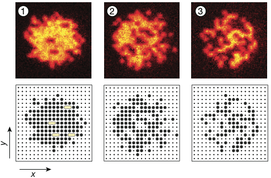Theory for nonlocal correlations:
We worked out a theoretical extension of nonlocal order to 2d systems showing that area correlations correspond to spatial Wilson loops in a dual description. Further, we theoretically investigated the out-of-equilibrium dynamics of non-local correlations.
We worked out a theoretical extension of nonlocal order to 2d systems showing that area correlations correspond to spatial Wilson loops in a dual description. Further, we theoretically investigated the out-of-equilibrium dynamics of non-local correlations.

Quantum dynamics of individual spins and magnon bound states:
We prepared individual spin impurities using single atom addressing and watched their dynamics.
We prepared individual spin impurities using single atom addressing and watched their dynamics.
Out-of-equilibrium dynamics of correlations:
Experimental observation of light-cone spreading of two-site correlations after a quantum quench of 1d Mott insulators.
Experimental observation of light-cone spreading of two-site correlations after a quantum quench of 1d Mott insulators.
Two-site and non-local correlation functions:
Using the quantum microscope, we detected correlation functions at the single particle level including a proof-of-principle that nonlocal observables are experimentally accessible. Such nonlocal quantities, taking into account detailed information of extended regions, are necessary for describing order in quantum phases that are beyond the standard Landau description (e.g., topological phases).
Using the quantum microscope, we detected correlation functions at the single particle level including a proof-of-principle that nonlocal observables are experimentally accessible. Such nonlocal quantities, taking into account detailed information of extended regions, are necessary for describing order in quantum phases that are beyond the standard Landau description (e.g., topological phases).
Detection of a Higgs mode close to a 2d quantum phase transition:
We observed an amplitude ‘Higgs’ modes close to the 2d superfluid-Mott insulator transition by measuring the dynamical response to lattice modulation with single-atom-sensitivity. The observability of ‘Higgs’ modes close to 2d quantum phase transitions has been debated and our measurements helped to resolve the discussion.
We observed an amplitude ‘Higgs’ modes close to the 2d superfluid-Mott insulator transition by measuring the dynamical response to lattice modulation with single-atom-sensitivity. The observability of ‘Higgs’ modes close to 2d quantum phase transitions has been debated and our measurements helped to resolve the discussion.
Development of a quantum microscope for optical lattices:
Development of a novel method for imaging and manipulating individual atoms in optical lattices.
Development of a novel method for imaging and manipulating individual atoms in optical lattices.
Wilson loops as probes for Bloch band topology:
In collaboration with the Bloch group, we are working on novel ways to probe the geometry of Bloch bands using Wilson loops and lines.
In collaboration with the Bloch group, we are working on novel ways to probe the geometry of Bloch bands using Wilson loops and lines.

Coupling of atoms to nanophotonic structures:
In collaboration with Misha Lukin's group, we are coupling individual Rubidium atoms to one-dimensional photonic crystal structures enabling interactions between the atoms and single photons. Our main goal is to extend the scheme to multiple atoms for entanglement generation and photon-induced atom-atom interactions.
In collaboration with Misha Lukin's group, we are coupling individual Rubidium atoms to one-dimensional photonic crystal structures enabling interactions between the atoms and single photons. Our main goal is to extend the scheme to multiple atoms for entanglement generation and photon-induced atom-atom interactions.
Optical lattice version of strained graphene:
In collaboration with David Pekker's group, we proposed a method to generate relativistic Landau levels by straining an optical lattice
In collaboration with David Pekker's group, we proposed a method to generate relativistic Landau levels by straining an optical lattice
Entanglement detection:
In collaboration with the Rosario Fazio's group, we theoretically proposed a method for spin-entanglement detection in optical lattices that was subsequently experimentally realized in a collaboration with the Bloch group.
In collaboration with the Rosario Fazio's group, we theoretically proposed a method for spin-entanglement detection in optical lattices that was subsequently experimentally realized in a collaboration with the Bloch group.
Detection of dynamical correlation functions:
In collaboration with Michael Knap's group at TU Munich, we are exploring new techniques for measuring dynamical correlation functions, including out-of-time ordered functions.
In collaboration with Michael Knap's group at TU Munich, we are exploring new techniques for measuring dynamical correlation functions, including out-of-time ordered functions.

Rydberg array quantum simulation with alkali atoms:
In collaboration with Misha Lukin's group at Harvard, we have been developing new techniques for quantum simulations based on Rydberg atom arrays. These experiments are based on atom-by-atom assembly of defect-free atomic arrays with optical tweezer.
In collaboration with Misha Lukin's group at Harvard, we have been developing new techniques for quantum simulations based on Rydberg atom arrays. These experiments are based on atom-by-atom assembly of defect-free atomic arrays with optical tweezer.
Effects of dynamically changing Berry phases:
In a theory collaboration with Gil Refael, we are exploring effects of dynamically changing Berry phases in optical lattices.
In a theory collaboration with Gil Refael, we are exploring effects of dynamically changing Berry phases in optical lattices.
Use of machine-learning techniques in quantum simulation experiments and many-body theory
We are investigating the use of machine-learning techniques applied to questions in quantum many body theory and experiments, specifically concerning quantum state reconstruction and numerical many-body methods in 2d.
We are investigating the use of machine-learning techniques applied to questions in quantum many body theory and experiments, specifically concerning quantum state reconstruction and numerical many-body methods in 2d.
Alkaline-earth atoms for quantum communication
In collaboration with Oskar Painter's group at Caltech, we worked out a new idea for quantum communication based on individually controlled alkaline-earth atoms coupled to cavity systems in the telecom range.
In collaboration with Oskar Painter's group at Caltech, we worked out a new idea for quantum communication based on individually controlled alkaline-earth atoms coupled to cavity systems in the telecom range.






